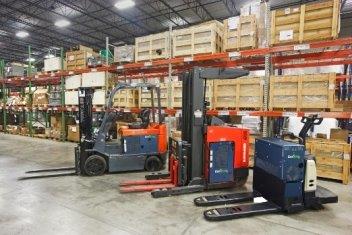 A family of GenDrive units |
John Cococcia is Business Development & Investor Relations VP at Plug Power.
Hydrogen fuel power has found its place in the industrial mobility world as a commercially viable alternative to traditional lead acid battery power. Today, hydrogen and fuel cells present an opportunity for businesses to not only drive meaningful economic benefits over the traditional lead acid battery solutions, but to go green in the process. In fact, hydrogen and fuel cells enable major companies to increase their productivity and reduce operational costs, all while lowering their greenhouse gas emissions.
Materials handling operations, large and small, are turning to fuel cells as the primary source of power for industrial mobility applications. At Plug Power, for instance, we've deployed fuel cell and hydrogen fuelling technology in more than 13,000 electric forklifts 24/7 with the company's GenDrive systems, and have deployed almost 140 hydrogen dispensers at customer sites. Customers have completed approximately 3.5 million refuelling on Plug Power GenFuel hydrogen fuelling stations with more than 10,000 refuelling on a daily basis. This installed base and market traction clearly demonstrates the commercial success of hydrogen-enabled solutions for mobility applications.
Last year, the US Congress designated October 8 as National Hydrogen and Fuel Cell Day to recognise this technology and its impact on reducing greenhouse gas emissions and increasing America's energy security.
For the industry at large, Plug Power included, the substantial adoption and growth of hydrogen and fuel cells in the materials handling market will enable businesses to continue to improve performance and drive down costs of both the fuel cells and the hydrogen infrastructure. This enables new applications for the technology, opening the possibility of hydrogen becoming one of the key energy sources in the next quarter century.
I have some thoughts on how captive vehicles, combined with proven success in materials handling and a decline in hydrogen fuel prices, will help to build the "hydrogen city" by the year 2040.
Getting to the Hydrogen CityThe advent of the hydrogen-powered car is a very exciting new market development that I think will contribute significantly to the growth of the overall hydrogen industry. But the hydrogen economy started with forklift trucks in distribution centres and manufacturers, and from this successful business model a market that is much bigger and broader is developing.
I call this the "hydrogen city" and it starts with growth of hydrogen solutions in "captive vehicles" like forklift trucks, yard dogs, ground support equipment and people movers. The simplification of hydrogen as a fuel enables these captive vehicles to be extensions of the hybrid fuel cell engines we put into forklifts today.
 John Cococcia |
The next set of applications will be "tethered vehicles", a market that shares some of the same characteristics as captive vehicles. These vehicles are tethered and local - that is, they are driven off of a lot and into the community, but come home each day. Examples include delivery trucks, shuttles, postal trucks and fleet cars. Over the next five years, this opportunity looks similar to that of the captive vehicles, where the fuelling infrastructure needed to support the fuel cell deployments can be economically sited and utilised.
Beyond that, in the next seven years, hydrogen will make inroads into non-industrial local equipment, like buses, taxis, fleet cars and utility vehicles, which will require a broader hydrogen fuel dispensing network that can be built on the foundation started by captive and tethered vehicles. Regional and national vehicles, such as cars, class 8 trucks, drones and autonomous vehicles, will come over time as we gain traction in the captive, tethered and local vehicles and as the network of hydrogen fuel improves.
Hydrogen CityTo get to the hydrogen city, the industry needs to develop a comprehensive plan and roadmap to fund, develop and implement a repeatable expansion of hydrogen fuel and mobile and stationary power applications for a regional deployment. The catalyst to this development is affordable, reliable hydrogen. This is not a "chicken or egg" scenario, but can be achieved with the thoughtful rollout and adoption of hydrogen generation technology for these new applications.
The 2040 Vision is achievableThe hydrogen fuel cell industry has outgrown its early reputation of developing "science projects", and now many see it as providing viable commercial products that deliver real benefits to customers for improved productivity and cost reduction, and, in many cases, also reduce greenhouse gas footprints. Accelerating sales of these commercial products allows hydrogen firms to push harder on research and development to advance the technology and reduce the costs around fuel cells and hydrogen, which will drive accelerated creation and adoption of new uses and applications of the technology - a beautiful, continuous cycle.
Even with this exciting vision of the future, it's important to remember that the market for hydrogen in distribution centres and other captive markets is a very large market with a lot of growth to be had in the coming years. To get to this hydrogen fuel cell future of 2040, it will take long-term vision, persistence, smart research, development and support from the industry.